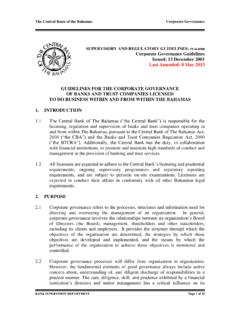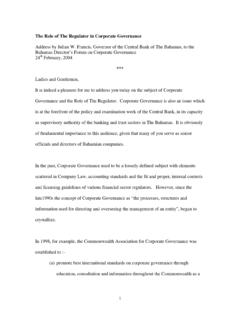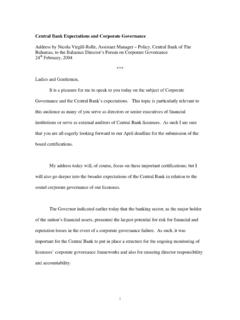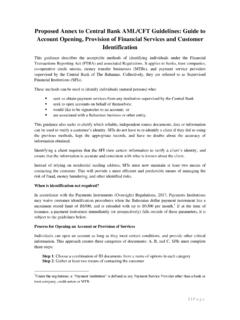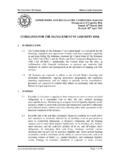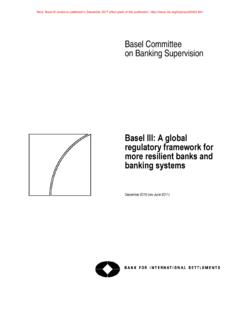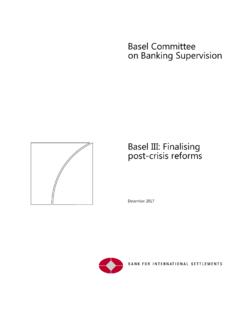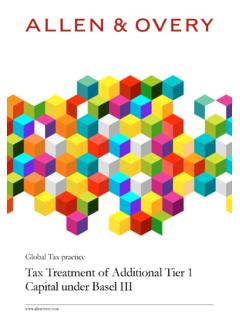Transcription of Extract from Basel III - A Global Regulatory Framework for ...
1 1/6 Extract FROM Basel III: A Global Regulatory Framework FOR more resilient BANKS AND BANKING SYSTEMS DEFINITIONS OF COMMON EQUITY TIER 1, ADDITIONAL TIER I AND TIER II CAPITAL I. Common Equity Tier 1 (CET1) Common Equity Tier 1 capital consists of the sum of the following elements: Common shares issued by the bank that meet the criteria for classification as common shares for Regulatory purposes (or the equivalent for non-joint stock companies); Stock surplus (share premium) resulting from the issue of instruments including CET1; Retained earnings; Accumulated other comprehensive income and other disclosed reserves.
2 1 Common shares issued by consolidated subsidiaries of the bank and held by third parties ( , minority interest) that meet the criteria for inclusion in CET1; and Regulatory adjustments applied in the calculation of CET1 Common shares issued by the bank For an instrument to be included in CET1 capital it must meet all of the criteria that follow. Criteria for classification as common shares for Regulatory capital purposes2 1. Represents the most subordinated claim in liquidation of the bank.
3 2. Entitled to a claim on the residual assets that is proportional with its share of issued capital, after all senior claims have been repaid in liquidation ( , has an unlimited and variable claim, not a fixed or capped claim). 3. Principal is perpetual and never repaid outside of liquidation (setting aside discretionary repurchases or other means of effectively reducing capital in a discretionary manner that is allowable under relevant law). 4. The bank does nothing to create an expectation at issuance that the instrument will be bought back, redeemed or cancelled nor do the statutory or contractual terms provide any feature which might give rise to such an expectation.
4 1 There is no adjustment to remove from CET1 unrealized gains or losses recognized on the balance sheet. Unrealized losses are subject to the Regulatory adjustments. 2 The criteria also apply to non joint stock companies, such as mutual funds, cooperatives or savings institutions, taking into account their specific constitution and legal structure. The application of the criteria should preserve the quality of the instruments by requiring that they are deemed fully equivalent to common shares in terms of their capital quality as regards loss absorption and do not possess features which could cause the condition of the bank to be weakened as a going concern during periods of market stress.
5 2/6 5. Distributions are paid out of distributable items (retained earnings included). The level of distributions is not in any way tied or linked to the amount paid in at issuance and is not subject to a contractual cap (except to the extent that a bank is unable to pay distributions that exceed the level of distributable items). 6. There are no circumstances under which the distributions are obligatory. Non payment is therefore not an event of default. 7. Distributions are paid only after all legal and contractual obligations have been met and payments on more senior capital instruments have been made.
6 This means that there are no preferential distributions, including in respect of other elements classified as the highest quality issued capital. 8. It is the issued capital that takes the first and proportionately greatest share of any losses as they occur3. Within the highest quality capital, each instrument absorbs losses on a going concern basis proportionately and pari passu with all the others. 9. The paid in amount is recognized as equity capital ( , not recognised as a liability) for determining balance sheet insolvency.
7 10. The paid in amount is classified as equity under the relevant accounting standards. 11. It is directly issued and paid-in and the bank can not directly or indirectly have funded the purchase of the instrument. 12. The paid in amount is neither secured nor covered by a guarantee of the issuer or related entity4 or subject to any other arrangement that legally or economically enhances the seniority of the claim. 13. It is only issued with the approval of the owners of the issuing bank, either given directly by the owners or, if permitted by applicable law, given by the Board of Directors or by other persons duly authorized by the owners.
8 14. It is clearly and separately disclosed on the bank s balance sheet. II. Additional Tier 1 capital Additional Tier 1 capital consists of the sum of the following elements: Instruments issued by the bank that meet the criteria for inclusion in Additional Tier 1 capital (and are not included in CET1); Stock surplus (share premium) resulting from the issue of instruments included in Additional Tier 1 capital; Instruments issued by consolidated subsidiaries of the bank and held by third parties that meet the criteria for inclusion in Additional Tier 1 capital and are not included in Common Equity Tier 1.
9 See section 4 for the relevant criteria; and Regulatory adjustments applied in the calculation of Additional Tier 1 Capital 3 In cases where capital instruments have a permanent write-down feature, this criterion is still deemed to be met by common shares. 4 A related entity can include a parent company, a sister company, a subsidiary or any other affiliate. A holding company is a related entity irrespective of whether it forms part of the consolidated banking group.
10 3/6 The treatment of instruments issued out of consolidated subsidiaries of the bank and the Regulatory adjustments applied in the calculation of Additional Tier 1 Capital are addressed in separate sections. Instruments issued by the bank that meet the Additional Tier 1 criteria The following box sets out the minimum set of criteria for an instrument issued by the bank to meet or exceed in order for it to be included in Additional Tier 1 capital. Criteria for inclusion in Additional Tier 1 capital 1.
